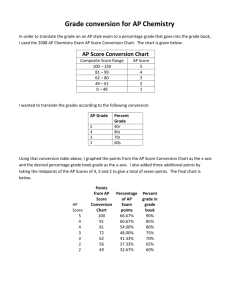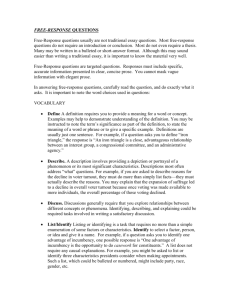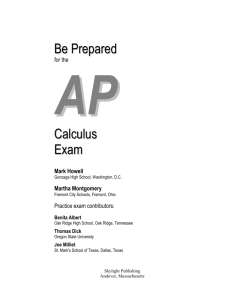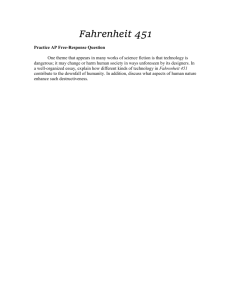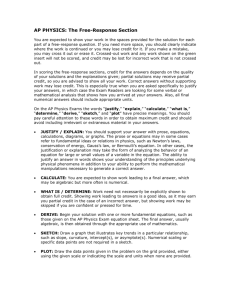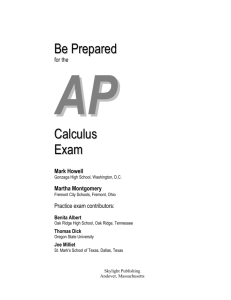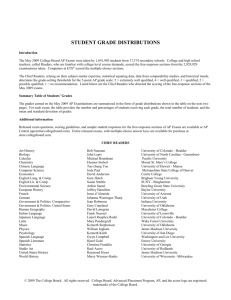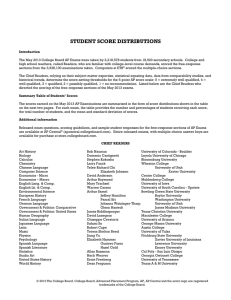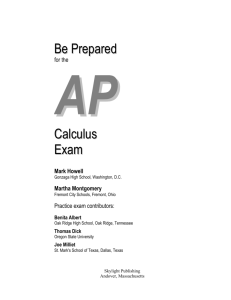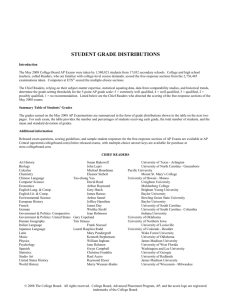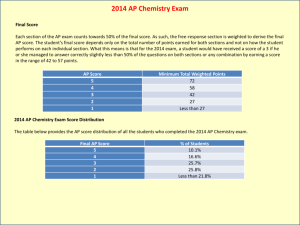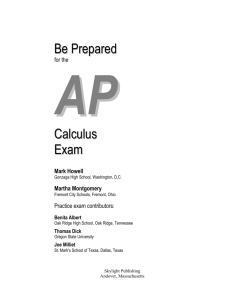Be Prepared for the AP Calculus Exam
advertisement
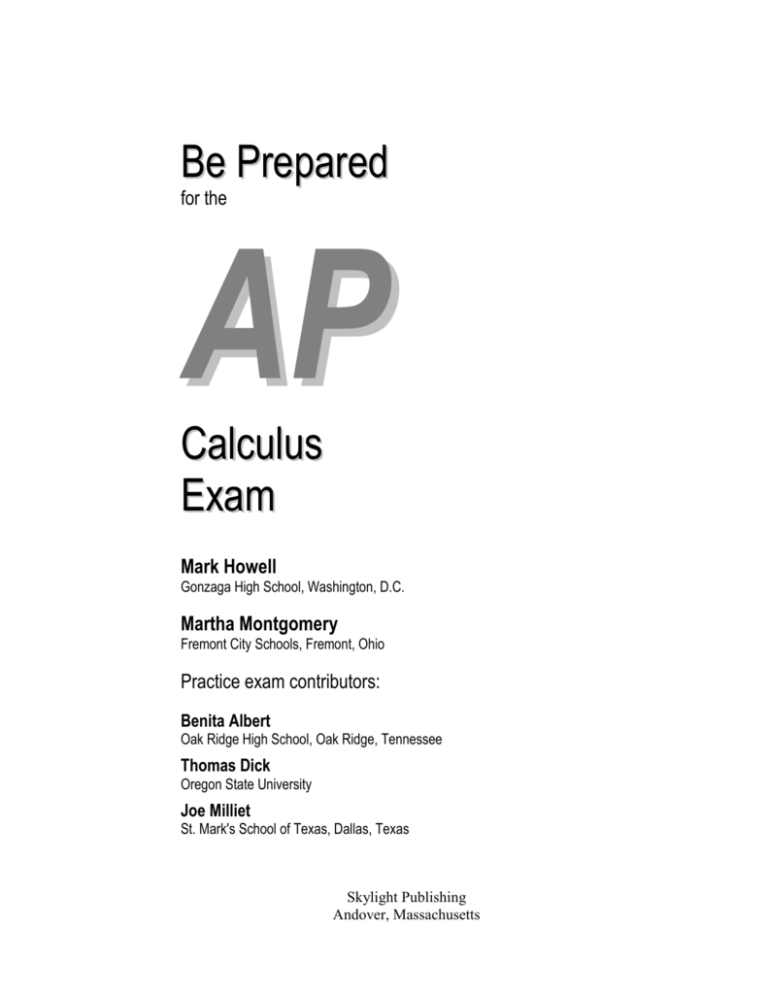
Be Prepared for the AP Calculus Exam Mark Howell Gonzaga High School, Washington, D.C. Martha Montgomery Fremont City Schools, Fremont, Ohio Practice exam contributors: Benita Albert Oak Ridge High School, Oak Ridge, Tennessee Thomas Dick Oregon State University Joe Milliet St. Mark's School of Texas, Dallas, Texas Skylight Publishing Andover, Massachusetts Copyright © 2005 by Skylight Publishing Chapter 10. Annotated Solutions to Past Free-Response Questions This material is provided to you as a supplement to the book Be Prepared for the AP Calculus Exam (ISBN 0-9727055-5-4). You are not authorized to publish or distribute it in any form without our permission. However, you may print out one copy of this chapter for personal use and for face-to-face teaching for each copy of the Be Prepared book that you own or receive from your school. Skylight Publishing 9 Bartlet Street, Suite 70 Andover, MA 01810 web: e-mail: http://www.skylit.com sales@skylit.com support@skylit.com 2003 AB AP Calculus Free-Response Solutions and Notes Question 1 (a) 1 y = x and y = e −3x intersect at a point (a, y) where­ a ≈ 0.238734 . Area of R = (b) 1 a ) x − e −3x dx ­ ≈ 0.443 . R = 1 − e −3 x ; r = 1 − x ; Volume = (c) ∫( ∫ 1 a 1 a b = x − e −3 x ; h = 5 Volume = ∫ 1 a ( ( π ( R 2 − r 2 ) dx = ∫ π (1 − e −3 x ) − 1 − x ( 2 ) ) dx ­ ≈ 1.424 . 2 ) x − e −3 x . 1 bh dx = ∫ 5 a ( x − e −3 x ) 2 dx ­ ≈ 1.554 . Notes: 1. Store a in a named variable in your calculator (see Appendix: Calculator Skills). 3 4 FREE-RESPONSE SOLUTIONS ~ 2003 AB Question 2 (a) a (2) = v′(2) ­ ≈ 1.587 . Since v(2) = −3sin(2) < 0 and a (2) > 0 , the velocity and acceleration have different signs1, so the speed is decreasing. (b) t2 = kπ ⇒ t = ± 2kπ . Of these values only 2 t = 2π falls into the interval 0 < t < 3. The velocity indeed changes its sign at that t2 point in time because the sign of (t + 1) does not change and the sign of sin 2 1 changes when t = 2π . We must have v(t ) = 0, so t = −1 or ∫ 3 2 v(t ) dt ­ ≈ 4.333 . (c) Distance traveled = (d) By the Candidate Test, the maximum distance over 0 ≤ t ≤ 3 can be reached at t = 2π or t = 0 or t = 3 . The distance from the origin 3 at t = 2π is x(0) + ∫ 2π 0 v(t ) dt 0 ­ ≈ 1 − 3.265 = 2.265 . 3 and at t = 3 is x(0) + ∫ v(t ) dt 0 The distance from the origin at t = 0 is 1 ­ ≈ 1 − 2.196 = 1.196 .4 The maximum is 2.265. Notes: 1. Justification is required for full credit. 2. This is shorter than 3. From the origin, not from x(0)! 4. Another line of reasoning may be used. Since the total distance traveled over 0 ≤ t ≤ 3 is 4.333 and the particle got to the position −2.265 , it will be still to the left of the origin at t = 3 and therefore the maximum distance from the origin cannot be reached at t = 3. ∫ 2π 0 v(t ) dt + ∫ 3 2π v(t ) dt . FREE-RESPONSE SOLUTIONS ~ 2003 AB Question 3 R(50) − R (40) 55 − 40 = = 1.5 gal/min 2 . 10 10 (a) R′(45) ≈ (b) R′′(45) = 0 since R′(t ) has a maximum at t = 45 . (c) ∫ 1 90 0 2 R(t ) dt ≈ 30 ⋅ 20 + 10 ⋅ 30 + 10 ⋅ 40 + 20 ⋅ 55 + 20 ⋅ 65 = 3700 gal . This approximation is less than the actual value because, for an increasing function, a left-hand Riemann sum underestimates the integral. (d) ∫ b 0 R(t ) dt (gal 3) is the total fuel consumed over the time interval 0 ≤ t ≤ b . 1 b R(t ) dt (gal/min 3) is the average rate of fuel consumption over the time b ∫0 interval 0 ≤ t ≤ b . Notes: 1. You have to give a correct reason for full credit. 2. An additional check: lengths of the subintervals, 30, 10, 10, 20, 20, must add up to 90. 3. Units must be specified for full credit. 5 6 FREE-RESPONSE SOLUTIONS ~ 2003 AB Question 4 (a) f is increasing on [–3, –2] since f ′( x) is positive for –3 < x < –2 (and nowhere else). (b) f ′ changes from decreasing to increasing at x = 0 and from increasing to decreasing at x = 2. Therefore, there are two points of inflection: at x = 0 and at x = 2. (c) y = f (0) + f ′(0) ⋅ x = 3 − 2 x . (d) f (−3) = f (0) + ∫ 0 1 f ′( x) dx = 3 − ∫ f ′( x) dx = 3 − − 2 . 1 0 −3 2 4 1 f (4) = f (0) + ∫ f ′( x) dx = 3 − 2 ⋅ 4 − π ⋅ 22 1, 2 0 2 −3 Notes: 1. 2. To save time and avoid mistakes, do not simplify further. 1 2 ⋅ 4 − π ⋅ 22 represents the area of the rectangle minus the area of the semicircle. 2 Since the region is below the x-axis, its contribution to the integral is negative. FREE-RESPONSE SOLUTIONS ~ 2003 AB 7 Question 5 (a) (b) 2 dV d (π r h ) dh dh dh −5π h h = = 25π ⇒ − 5π h = 25π . Therefore, . = =− dt 25π 5 dt dt dt dt dh h dh dt =− ⇒ =− ⇒ dt 5 5 h ∫ dh dt 1 = −∫ ⇒ 2 h = − t +C . 5 5 h 2 1 2 − 5 t + 2 17 1 = − + t 17 h(0) = 17 ⇒ C = 2 17 , h = . 2 10 (c) h(t ) = 0 ⇒ − 1 t + 17 = 0 ⇒ t = 10 17 . 10 8 FREE-RESPONSE SOLUTIONS ~ 2003 AB Question 6 (a) Yes. lim− f ( x) = x + 1 x →3 x =3 = 2; lim+ f ( x) = ( 5 − x ) x =3 = 2 . Therefore, x →3 lim f ( x) = 2 = f (3) . x →3 (b) ∫ 5 0 f ( x)dx = ∫ 3 3 0 5 x + 1 dx + ∫ ( 5 − x ) dx = 3 5 3 2 x2 2 25 9 20 ( x + 1) 2 + 5 x − = ( 8 − 1) + 25 − − 15 + = . 3 2 3 3 2 2 3 0 1 5 4 The average is ∫ f ( x)dx = . 5 0 3 (c) g(x) is continuous at x = 3, so k 3 + 1 = m ⋅ 3 + 2 ⇒ 2k = 3m + 2 . k for 0 < x < 3 g ′( x) = 2 x + 1 m for 3 < x < 5 k g ′( x) exists at x = 3, so = m ⇒ k = 4m . Substituting this expression for k in the 4 2 8 first equation, we get 8m = 3m + 2 ⇒ m = . k = 4m = . 5 5 2003 BC AP Calculus Free-Response Solutions and Notes Question 1 See AB Question 1. Question 2 (a) Both x and y are decreasing along the segment BD of the curve, so both dx dy and dt dt are negative or zero at point C. (b) At point B, πt = π π t +1 dx πt = 0 ⇒ cos = 0 or sin = 0 . For t > 0, dt 6 2 + kπ (k = 0,1, 2,...) or π t +1 6 2 2 1 solution for 0 < t < 9 is t = 3. (c) x′(8) = −9 cos = kπ (k = 1, 2,...) . The only possible 8π π 8 +1 9 y′(8) 5 5 sin =− . = ⇒ y′(8) = − . The velocity is 6 2 2 x′(8) 9 2 9 5 x′(8), y′(8) = − , − . The speed is 2 2 (d) Distance = ∫ 9 0 x′(t ) dt 2 2 9 5 x′(8) 2 + y′(8) 2 = + . 2 2 2 ­ ≈ 39.255 . Notes: 1. From the first equality, t = 3 + 6k . 0 < t < 9 only when k = 0, t = 3. From the second equality, t = 4k 2 − 1 . 0 < t < 9 only when k = 1, t = 3. It is a “coincidence” that t = 3 satisfies both equations. 2. Leave it at that to save time and avoid arithmetic mistakes. 9 10 FREE-RESPONSE SOLUTIONS ~ 2003 BC Question 3 (a) 5 5 5 3 25 y = 1 + y 2 ⇒ − 1 y 2 = 1 ⇒ y = . x = y ⇒ x = . 3 4 3 4 9 3 dx 2y 3 4 = = = .1 2 dy 2 1 + y 9 5 1+ 16 ∫ 3 4 0 5 2 1 + y − y dy ­ ≈ 0.346 . 3 (b) Area of S = (c) x = r cos θ ; y = r sin θ ⇒ x 2 − y 2 = 1 ⇔ r 2 cos 2 θ − r 2 sin 2 θ = 1 ⇔ r 2 = (d) Area of S = ∫ ( 5) r2 tan −1 3 0 2 dθ = ∫ ( 5) tan −1 3 1 dθ .2 2 2 ( cos θ − sin θ ) 2 0 Notes: 1. You might notice that 2. Or ∫ ( 3) cot −1 5 0 2y 2 1+ y ... (same as above). 2 = 1 . cos θ − sin 2 θ 2 y 3 = . x 5 FREE-RESPONSE SOLUTIONS ~ 2003 BC Question 4 See AB Question 4. Question 5 See AB Question 5. 11 12 FREE-RESPONSE SOLUTIONS ~ 2003 BC Question 6 (a) Since the coefficient of the x term in this Maclaurin series is 0, f ′(0) = 0 . Since the 1 coefficient of the x2 term in this Maclaurin series is − , 3! f ′′(0) 1 1 = − ⇒ f ′′(0) = − . The first derivative of f is 0 and the second derivative 2 3! 3 is negative, so f has a local maximum at x = 0. (b) This is a converging alternating series with decreasing terms, so the absolute value 1 1 1 of the error is less than the first omitted term: f (1) − 1 − < < . 3! 5! 100 (c) y′ = −2 x x3 x5 x 2 n −1 n + 4 − 6 + ... + ( −1) 2n + ... 1 3! 5! 7! ( 2n + 1)! x2 x4 x6 x2n n xy′ + y = −2 + 4 − 6 + ... + ( −1) 2n + ... 5! 7! ( 2n + 1)! 3! x2 x 4 x6 x 2n n + 1 − + − + ... + ( −1) + ... = ( 2n + 1) ! 3! 5! 7! x2 x4 x6 x2n n + ... = 1 − 3 + 5 − 7 + ... + ( −1) ( 2n + 1) 3! 5! 7! ( 2n + 1)! = 1− 2n x2 x4 x6 n x + − + ... + ( −1) + ... = cos x . 2! 4! 6! ( 2n ) ! Notes: 1. This problem does not ask you to write formulas for the general term of each series involved, and it may be easier, in fact, to work without general terms. However, when this question was graded, there was a considerable debate as to how many terms had to be shown for full credit. For those who worked with general terms, there was no such question. 2. If you notice that the given series multiplied by x is the series for sin x and that xy′ + y = ( xy )′ , your proof can be greatly simplified: xy = x − x3 x5 x 7 + − + ... = sin x ⇒ ( xy )′ = cos x . 3! 5! 7! 2003 AB (Form B) AP Calculus Free-Response Solutions and Notes Question 1 (a) f ′(3) = 8 x − 3 x 2 = −3 . The tangent line to the graph of f ( x) at x = 3 is x =3 y = f (3) + f ′(3) ⋅ ( x − 3) = 9 + (−3) ⋅ ( x − 3) = −3 x + 18 , the same as l. (b) y = f ( x) intersects the x-axis at x = 4 and l intersects the x-axis at x = 6. Area of 1 27 + MPQ = (6 − 3) ⋅ f (3) = . Area of 2 2 y P 4 S = area of +MPQ − ∫ f ( x) dx = 3 4 27 − ∫ ( 4 x 2 − x 3 ) dx ­ ≈ 7.917 . 3 2 (c) Volume = π ∫ 4 0 ( 4x 2 M 3 Q 4 6 x − x 3 ) dx ­ ≈ 490.208 . 2 13 14 FREE-RESPONSE SOLUTIONS ~ 2003 AB (FORM B) Question 2 ∫ 12 H (t ) dt ­ ≈ 70.571 gallons. (a) Amount of oil pumped in = (b) Falling. The rate of change of the volume is [ H (t ) − R(t ) ] t =6 ­ ≈ −2.924 < 0 . (c) Volume = 125 + ∫ (d) Applying the Candidate Test. V(0) = 125. V(125) = 122.026 (from Part (c)). Local dV = 0 ⇒ H (t ) = R(t ) ⇒ ­ t ≈ 4.790 or t ≈ 11.318 . minima may occur when dt 12 0 V (4.790) = 125 + ∫ [ H (t ) − R(t )] dt ­ ≈ 122.026 4.790 0 V (11.318) = 125 + ∫ 0 [ H (t ) − R(t )] dt ­ ≈ 149.4 .1 11.318 0 is at t = 11.318 hours. gallons. [ H (t ) − R(t )] dt ­ ≈ 120.7 . The absolute minimum for V(t) 2 Notes: 1. Instead of calculating V(4.790) you could state that H (t ) − R (t ) is positive for t < 4.790, so V(t) can’t have a local minimum at t = 4.790. 2. Simply graphing V (t ) = ∫ [ H (τ ) − R (τ ) ] dτ and finding its minimum will not get t 0 you full credit because reading a maximum or minimum from a graph is not a permitted calculator operation. FREE-RESPONSE SOLUTIONS ~ 2003 AB (FORM B) 15 Question 3 1 360 B( x) dx . 1 ∫ 0 360 2 (a) Average radius = (b) 1 360 B( x) 1 1 1 dx ≈ ⋅120 ⋅ [ B(60) + B(180) + B(300) ] = ( 30 + 30 + 24 ) . ∫ 0 360 2 360 2 6 (c) This integral represents the total volume (in mm3)2 of the segment of the blood vessel between x = 125 and x = 275. (d) By the MVT, B′( x) > 0 for some 0 ≤ x ≤ 60 and B′( x) < 0 for some 60 ≤ x ≤ 120 . Therefore (by the IVT), B′( x1 ) = 0 for some 0 ≤ x1 ≤ 120 . Similarly, B′( x) < 0 for some 180 ≤ x ≤ 300 and B′( x) > 0 for some 300 ≤ x ≤ 360 , so B′( x2 ) = 0 for some 180 ≤ x2 ≤ 360 . Applying the MVT (or, its special case, Rolle’s theorem) to B′( x) we conclude that B′′( x) = 0 for some x1 < x < x2 .3 Notes: 1. Average radius, not diameter! 2. You must state the units to get full credit. 3. You may notice that B(60) = B(180), so by the MVT (or Rolle’s) B′( x1 ) = 0 for some x1 from [60, 180]. The same for some x2 from [240, 360]. From the MVT (or Rolle’s) applied to B′( x) , we conclude that B′′( x) must be equal to 0 somewhere between x1 and x2. 16 FREE-RESPONSE SOLUTIONS ~ 2003 AB (FORM B) Question 4 (a) a(t ) = v′(t ) = −e1−t . a (3) = v′(3) = −e −2 . (b) Since v(3) = −1 + e −2 < 0 and a (3) < 0 , the velocity and acceleration have the same sign 1, so the speed is increasing. (c) We must have v(t ) = 0, so t = 1 . The velocity indeed changes sign at t = 1: 2 v(t ) > 0 for t < 1 and v(t ) < 0 for t > 1 . (d) Distance traveled = ∫ 3 0 1 3 v(t ) dt = ∫ −1 + e1−t dt + ∫ −1 + e1−t dt = 0 1 ( −t − e ) − ( − t − e ) = ( − 2 + e ) − ( − 1 − e ) = −1 + e + e 1−t 1 0 1−t 3 −2 −2 1 Notes: 1. Reason is required for full credit. 2. Justification is required for full credit. 3. Or: x(t ) = −t − e1−t ⇒ x(0) = −e; x(1) = −2; x(3) = −3 − e −2 . Distance traveled = ( x(1) − x(0) ) + ( x(1) − x(3) ) = −1 + e + e −2 . .3 FREE-RESPONSE SOLUTIONS ~ 2003 AB (FORM B) 17 Question 5 3 2−4 = −2 . 3− 2 (a) g (3) = ∫ f (t ) dt = 3 . g ′(3) = f (3) = 2 . g ′′(3) = f ′(3) = (b) The rate of change of g is f. The average of f(x) on 0 ≤ x ≤ 3 is 3 1 3 1 2 1 7 f (t ) dt = ∫ f (t ) dt + ∫ f (t ) dt = (4 + 3) = . ∫ 2 3 0 3 0 3 3 (c) Again, g ′(c) = f (c) . The line y = 2 ( ) 7 intersects the graph of f in two points with 3 x-coordinates in the interval (0, 3). (d) g ′ (which is f) changes from increasing to decreasing at x = 2 and from decreasing to increasing at x = 5. Therefore, there are two inflection points: at x = 2 and at x = 5. 18 FREE-RESPONSE SOLUTIONS ~ 2003 AB (FORM B) Question 6 (a) f ′′( x) = d d f ′( x) = x f ( x) = dx dx f ( x) + x f ′( x) = 2 f ( x) f ( x) + x2 . 2 9 f ′′(3) = 25 + . 2 (b) dy =x y ⇒ dx ∫ dy x2 = ∫ x dx ⇒ 2 y = + C . 2 y 2 1 x 2 11 32 9 11 2 25 = + C ⇒ C = 10 − = . y = + .1 2 2 2 2 2 2 Notes: 1. You have to solve for y but stop here, do not simplify any further. 2003 BC (Form B) AP Calculus Free-Response Solutions and Notes Question 1 See AB Question 1. Question 2 (a) Area of R = (b) Area of R = (c) Area of R = ∫ ∫ ∫ 1 1 − ( x − 1) dx + ∫ 2 0 1 0 2 1 2 − x 2 dx . ) ( 2 − y 2 − 1 − 1 − y 2 dy .1 π 4 0 ( 2) 2 2 ( 2 cos θ ) dθ .2 dθ + ∫ π 2 π 2 2 4 Notes: 1. In x = 1 ± 1 − y 2 we choose 1 − 1 − y 2 because we need x < 1. 2. Just set up, do not simplify anything. Question 3 See AB Question 3. 19 20 FREE-RESPONSE SOLUTIONS ~ 2003 BC (FORM B) Question 4 (a) Velocity vector = 6e3t − 7e −7 t , 9e3t + 2e −2t . The speed = [ x′(0)] + [ y′(0)] 2 2 = ( −1) 2 + 112 . (b) dy dy 9e3t + 2e−2t 9 dy dt 9e3t + 2e −2t = = 3t . lim = = . dx dx 6e − 7e −7 t t →∞ dx 6e3t − 7e −7 t 6 dt (c) The tangent line is horizontal when 9e 3 t + 2e − 2 t (d) dy = 0 ⇔ 9e3t + 2e −2t = 0 . Since dt > 0 for all t, no such t exists. The tangent line is vertical when dx 7 1 7 = 0 ⇔ 6e3t − 7e−7 t = 0 ⇔ e3t + 7 t = ⇔ t = ln . dt 6 10 6 Question 5 See AB Question 3. FREE-RESPONSE SOLUTIONS ~ 2003 BC (FORM B) Question 6 (a) (b) f ′′(2) f ′′′(2) ( x − 2) 2 + ( x − 2)3 + ... + 2! 3! n f ( ) (2) ( x − 2) n + ... = n! ( n + 1) ! ( x − 2)n + ... = 2! 3! 4! 1 + ( x − 2) + ( x − 2) 2 + ( x − 2)3 + ... + 2 3 3 2!3 3!3 n !3n ( n + 1) ( x − 2)n + ... 2 3 4 1 + ( x − 2) + 2 ( x − 2) 2 + 3 ( x − 2)3 + ... + 3 3 3 3n f ( x) = f (2) + f ′(2)( x − 2) + By the Ratio Test, the series converges when n+2 ( x − 2) n +1 n +1 x−2 n+2 x−2 lim 3 lim = = < 1 . The series diverges when n →∞ n + 1 n →∞ n + 1 3 3 n ( x − 2) 3n x−2 > 1 . The radius of convergence is 3. 3 (c) 1 1 1 1 g ( x) = 3 + ( x − 2) + ( x − 2) 2 + 2 ( x − 2)3 + 3 ( x − 2) 4 + ... + n ( x − 2) n +1 + ... 3 3 3 3 (d) The series for g diverges at x = −2 because the n-th term does not approach 0: ( −4 ) lim n →∞ 3n n +1 n 4 4 = −4 ⋅ lim − does not exist because − > 1 . n →∞ 3 3 21
